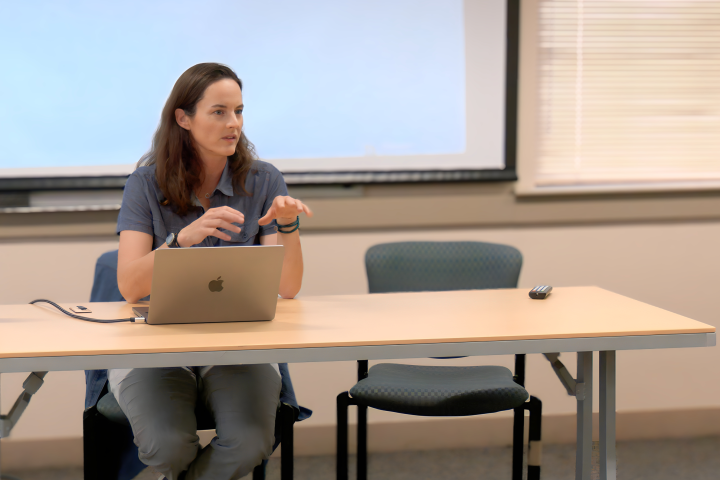Hanover residents heard an update on Dartmouth’s decarbonization program at a community meeting this week at which program officials explained the electricity-driven, low-carbon energy system that will replace the institution’s aging fossil-fuel-powered steam-heating plant.
A geo-exchange system that uses the ground as a source of heating and cooling is a centerpiece of President Sian Leah Beilock’s pledge to decarbonize campus operations by 60% by 2030 and 100% by 2050. Dartmouth is investing more than $500 million in the work, making it the largest infrastructure project the institution has undertaken.
“These carbon goals are pretty audacious,” Dartmouth’s Director of Sustainability Rosi Kerr ’97, told the approximately 20 residents who attended the Aug. 14 meeting in the Hanover RWB Community Center.
Kerr said Dartmouth officials want to keep talking with residents about the program and directed them to a website that explains the work and provides up-to-date construction details. In addition, she said Dartmouth will continue to meet with neighbors as the project progresses.
The program is part of the Dartmouth Climate Collaborative, which includes faculty research on a variety of climate-related topics and use of the campus as a living laboratory for students and scholars taking on complex sustainability challenges.
This summer, underground piping and electrical duct banks are being installed in several locations around campus and will eventually connect to a geo-exchange pump plant that will be connected to a series of borefields that hold hundreds of 800-foot-deep wells that effectively use the subsurface of the Earth as a thermal battery.
The first of the borefields will be installed this fall on a practice soccer field in the Athletics District, said Kerr. She and Patrick O’Hern, senior director of project management services, told residents that the borefield work will begin at the end of October, when five drilling rigs will dig 187 deep wells on the site, working for about 16 weeks, then taking a break during the coldest months of winter and returning in the early spring to finish drilling and then reconstruct the field. In all, the first borefield will take about a year to complete.
Residents asked about access to the worksite, drill rig noise, and the hours construction will take place. They wanted to know the location of the pump plant and future borefields. A location for the first plant—plans are to likely have two plants—will be somewhere in the Athletics District, and sites for the next borefields haven’t yet been finalized, said O’Hern.
He said they are working with contractors to set daily work hours and establish site access, and are considering various ways to mitigate sound from the drilling rigs, including possibly installing a sound-muffling wall and other sound mitigation measures at the site.
“This is a huge initiative for all of us,” he said.
Resident Judi Colla said after the meeting that she wants to be sure residents know how to stay updated on the energy transformation.
“We are so pleased with Dartmouth’s commitment to decarbonization,” said Colla, who co-chairs Sustainable Hanover, a town committee that works on a variety of projects, including helping Hanover transition to using 100% renewable energy for electricity by 2030 and for heating, cooling, and transportation by 2050.
“Dartmouth’s decarbonization website is nifty for understanding what the College is doing and getting construction updates. Also, in-person updates, such as the one Dartmouth hosted on Wednesday, are especially helpful for expressing concerns and getting questions answered. Sustainable Hanover hopes to help spread the word for the follow-up tentatively scheduled for early October.”
Hanover residents aren’t the only ones interested in Dartmouth’s decarbonization program. Dartmouth representatives working on the project took part last month in a webinar sponsored by Sen. Edward Markey, D-Mass. The webinar, Unlocking Clean Energy Opportunities for Universities and Other Higher Education Institutions, was about how universities can take advantage of clean energy tax credits through the federal Inflation Reduction Act, signed into law in 2022.
“This is the largest climate and clean energy bill in the history of the world and the funding is in there for all of you, and these landmark new programs make it possible for universities and community colleges and others to fight for the future of our planet as they educate the climate leaders of our future,” Markey said.
Erik Bray, director of Dartmouth’s energy transition, told the webinar audience that “the good news is that the timing of Dartmouth’s program aligns well with the timeline of the IRA.”

